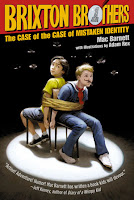 Summary
Summary Amelia and Eleanor go for a Ride is about a dinner in which Eleanor Roosevelt’s guest at the White House was Amelia Earhart. Both the women are adventurous and outspoken and have become friends. Amelia takes Eleanor for a plane ride during a clear night. The look at the twinkling lights of Washing D.C. After returning to the White House, Eleanor takes Amelia for a fast ride in her new car. Both the women are characterized by their love of exploration and desire to feel independent.
Impressions The cover of the book initially caught my attention. Brian Selznick did the illustrations which
are a great addition to the story. In
the author’s note it is mentioned that the dinner, meeting, and flight was a
real event. However, some aspects were fictionalized.
At the end of the book there is a picture of the two women together. Also, through
the story, the reader also gains insight into the time period and the norms at
the White House.
Reviews
In this sparkling picture book based on true incident,
Ryan (Riding Freedom, with Selznick) proves that Amelia Earhart and Eleanor
Roosevelt truly were "birds of a feather." Friends in real life,
America's First Lady invited the "First Lady of the Air" to dinner at
the White House in 1933. Eleanor, inspired by Amelia's descriptions of
Washington viewed from her plane at night, accepts the pilot's offer of an after
dinner flight over the capital. Before dessert can be served, and over the
protests of the Secret Service agents, the two are off to the airport and up in
the sky, thrilling to the brilliance of the city below. Hewing closely to
documented accounts, Ryan's inviting text adds drama and draws parallels between
the two protagonists with fictional touches: she places them alone together in
the plane (an author's note explains that in fact they were accompanied by two
male pilots) and adds a final scene in which Eleanor takes Amelia for a zippy
ride around the city in her brand-new car. Selznick's illustrations,
black-and-white graphite accented with touches of purple pencil, both capture
the vibrancy of his subjects and evoke the feel of a more glamorous era. A
brief but compelling slice from the lives of two determined, outspoken and
passionate women. Ages 5-9. (Oct.)
Roback, D., Brown, J. M., & Di Marzo, C. (1999). Amelia and
eleanor go for a ride. Publishers Weekly, 246(39), 105-105. Retrieved
from http://search.proquest.com/docview/197026982?accountid=7113
Gr 14-Ryan imaginatively expands on a true historical event in this
intriguing picture book. While dining at the White House in 1933, Amelia
Earhart convinces Eleanor Roosevelt to join her on a night flight to Baltimore.
The two women marvel at the sights and the excitement from the air. After
landing, they sneak away for one more adventure, as this time, the First Lady
treats her friend to a fast ride in her new car. The fictionalized tale is
lively and compelling, and the courage and sense of adventure that these
individuals shared will be evident even to children who know nothing about
their lives. Without belaboring the message, the author clearly conveys how the
"feeling of independence" that both women treasured was a crucial
part of their personalities. Selznick's larger-than-life pencil drawings add
considerably to the spirit of the tale. He captures the glorious beauty of the
night flight and the beauty of the city below. Varied perspectives and
background details consistently draw readers' eyes. An author's note clearly
defines which elements of the story are factual. The women were actually
accompanied by two male pilots, but the author decided that it made it
"much more exciting" to imagine that they were alone. "Almost
all" of the dialogue comes from historical accounts. The title stands well
on its own, but will also work as an excellent inspiration for further reading
about the lives of Eleanor Roosevelt and Amelia Earhart.-Steven Engelfried,
Deschutes County Library, Bend, OR
Engelfried, S. (1999). Amelia and eleanor go for a ride. School Library
Journal, 45(9), 202-203. Retrieved from
http://search.proquest.com/docview/211696454?accountid=7113
Suggestions
This book would be good for a women in history unit for elementary students. Even though the book is fiction, there are many historically correct facts that the student could use.
This book would be good for a women in history unit for elementary students. Even though the book is fiction, there are many historically correct facts that the student could use.
The students could also discuss some historical figure they
would like to meet. They could plan the
dinner and events they would do together.
References
Ryan, P. M.
(1999). Amelia and eleanor go for a ride. New York: Scholastic Press.
http://lookingglassreview.com/assets/images/Amelia_and_Eleanor_go_for_a_ride.jpg


